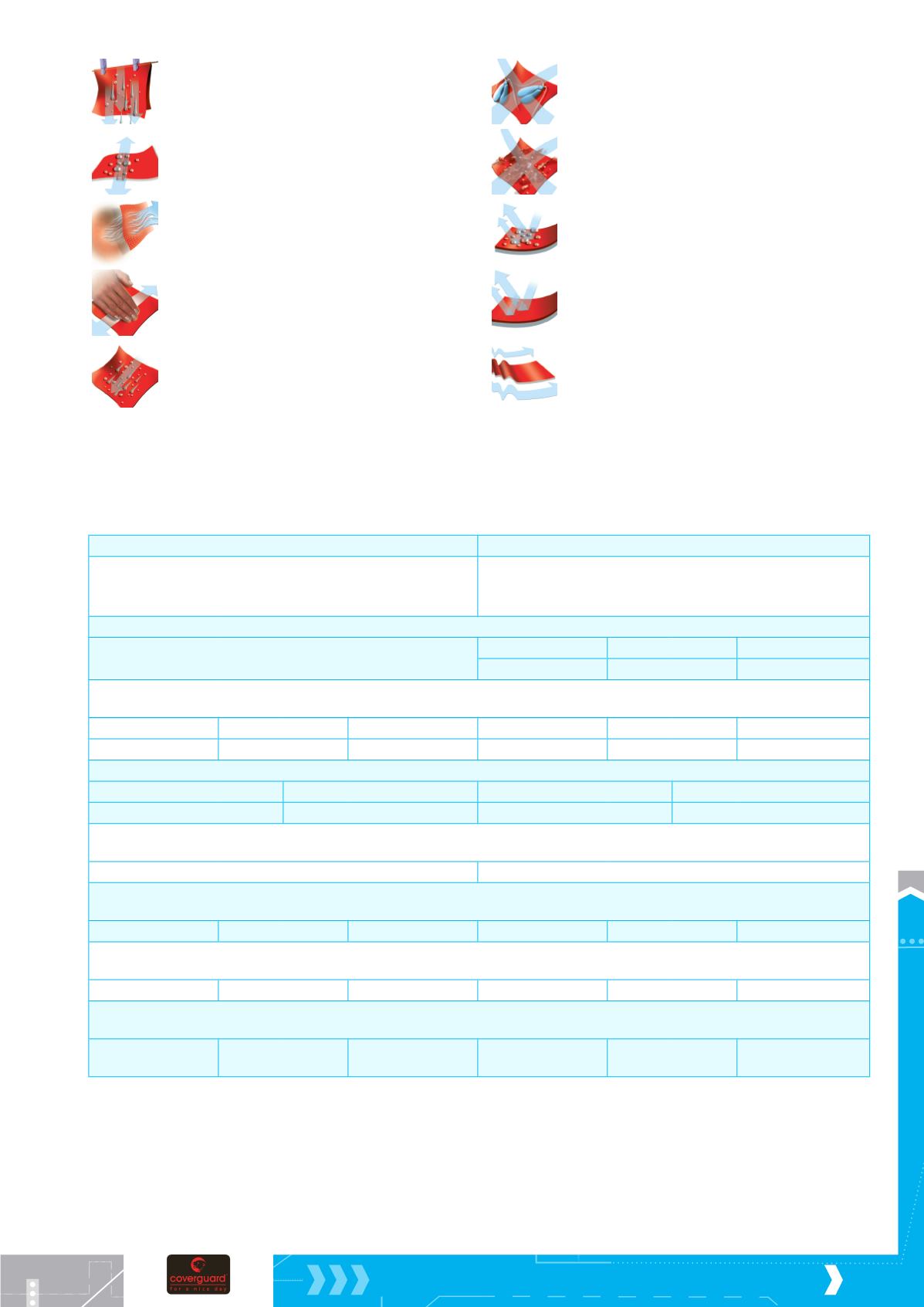
305
WATER REPELLENT
The fabric does not absorb water (hydrophobic)
and dries quickly after washing.
AIRTIGHT
As a result of the welding process the seams are
waterproof.
BREATHABLE
The micro porous membrane fabric allows body
moisture to escape but doesn’t allow external
moisture in and so doesn’t get clammy with wear.
SOFT
Smoothing process which results in the fabric’s
silk-like feel.
WATER REPELLENT
Finishing process which causes liquids (water,
oil and other contaminants) to run off the surface
of the fabric.
MOTHPROOF
Synthetic fabrics do not require mothproofing
treatment.
PILLING PROOF
A special process which prevents the fabric’s
fibers from tangling and pilling as a result of
washing and wear.
WATERPROOF
A coating (e.g. PU, PVC) applied to the surface of
the fabric making it waterproof and more durable.
WINDPROOF
A fabric of several layers, including film, which
is impervious to wind and maintains body
temperature.
NON-CREASE
A special weaving process results in the fibers of
the fabric flattening and returning to their original
shape after use.
COVERGUARD
®
• FABRICS AND SIZES
EN 342:2004
EN 14058:2004
Clothing ensembles (all garments covering upper and lower
body in extreme cold, cold store conditions) for protection
against a humid, damp, windy environment below -5°C.
Garments (waistcoats, coats, trousers preventing cooling of body
areas covered, with or without removable linings) for protection
against a humid, damp, windy environment above -5°C.
Rct
= insulation (m
2
xK/W), heat resistance of all layers, dry heat flow permeating a given cross section
0,25 ≤ Rct
1. Rating
2. Rating
3. Rating
0.06 ≤ Rct < 0.12 0.12 ≤ Rct < 0.18 0.18 ≤ Rct < 0.25
AP
= air permeability (mm/s), test of the entire garment (layers, seams)
with a pressure differential of 100 Pa on the given area.
1. Rating
2. Rating
3. Rating
1. Rating
2. Rating
3. Rating
100 < AP
5 < AP ≤ 100 AP ≤ 5 (airtight)
F) 100 < AP F) 5 < AP ≤ 100
F) AP ≤ 5
WP
= water penetration resistance (Pa), test of the outer fabric and seams under increasing water pressure
1. Rating
2. Rating
1. Rating
2. Rating
F)
8000 ≤ WP ≤ 13000
F)
WP > 13000 (waterproof)
F)
8000 ≤ WP ≤ 13000
F)
WP > 13000 (waterproof)
Ret
= water vapor transition resistance (m
2
xPa/W), evaporative heat flow (passing, diffusing) through a given cross
section, following the WP test
Ret > 55
Ret > 55
Icle = static situation
measure for the insulation coefficient (m
2
xPa/W), and the lowest external temperature
which can be maintained for 8 hours
Icle ≥ 0.310 (11 °C) Icle ≥ 0.470 (3 °C) Icle ≥ 0.620 (-7 °C) Icle ≥ 0.170 (19 °C) Icle ≥ 0.230 (15 °C) Icle ≥ 0.310 (11 °C)
Icler = low intensity movement
situation measure for the insulation coefficient (m
2
xPa/W), and the lowest external
temperature which can be maintained for 8 hours
Icler ≥ 0.31 (-1 °C) Icler ≥ 0.47 (-15 °C) Icler ≥ 0.62 (-29 °C) Icler ≥ 0.17 (11 °C) Icler ≥ 0.23 (5 °C) Icler ≥ 0.31 (-1 °C)
Icler = moderate intensity movement
situation measure for the insulation coefficient (m
2
xPa/W), and the lowest
external temperature which can be maintained for 8 hours
Icler ≥ 0.31 (-19 °C) Icler ≥ 0.47 (-38 °C)
Icler ≥ 0.62 (-60
°C)
Icler ≥ 0.17 (0 °C) Icler ≥ 0.23 (-8 °C) Icler ≥ 0.31 (-19 °C)
Protective clothing for use in cool and cold conditions
According to Joint Decree No.3/2002 (8 Feb.) of the Ministry of Social Affairs and the Family and of the Ministry of Health,
a workplace shall be regarded as cold when the expected average daily temperature does not reach +4°C outdoors and
+10°C indoors for over 50% of the working hours. The EN342:2004 and EN14058:2004 standards on garments and clothing
combinations, for parts of or the entire body, against cool environments specify -5°C as the limit of cold ambient temperature
in a possible combination with humidity and wind.
F)
= optional test
Basic factors to be considered in protection against cold
• the standard applies to the insulation measure for the entire ensemble, specifying the kind of underclothing as well (e.g. B
type underclothing for standard EN14058: long sleeved vest, long johns, knee-length socks, footwear, shirt, pants, pullover
and for standard EN342: long sleeved vest, long johns, knee-length socks, footwear, thermal pants and top, knitted gloves
and cap). • clothing ensembles and garments can lose their insulating properties as a result of washing and wear • the
relative humidity and wind speed significantly affect convective heat loss (the standard’s parameters: 50% humidity and
wind speed of 0.5 m/s ) • the intensity of the work and perspiration are also determining factors in the degree of insulation.


